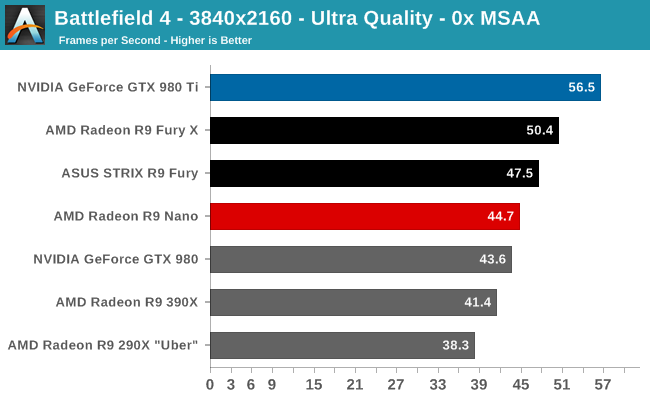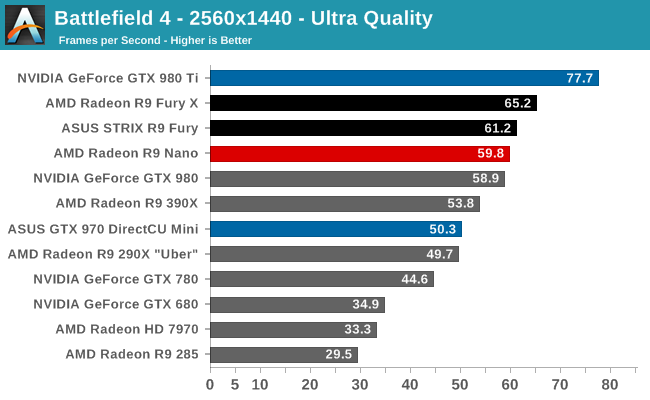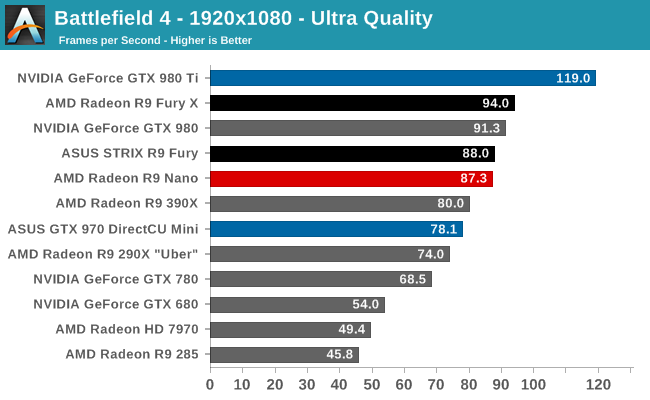The AMD Radeon R9 Nano Review: The Power of Size
by Ryan Smith on September 10, 2015 8:00 AM ESTBattlefield 4
Kicking off our benchmark suite is Battlefield 4, DICE’s 2013 multiplayer military shooter. After a rocky start, Battlefield 4 has since become a challenging game in its own right and a showcase title for low-level graphics APIs. As these benchmarks are from single player mode, based on our experiences our rule of thumb here is that multiplayer framerates will dip to half our single player framerates, which means a card needs to be able to average at least 60fps if it’s to be able to hold up in multiplayer.




Like the other Fiji cards, AMD is promoting the R9 Nano in part on its 4K capabilities. And while we disagree that this card is suitable for 4K gaming based on its sub-Fury performance, we’re including 4K results anyhow to serve as a point of comparison.
In any case Battlefield 4 is often a good indicator of general card performance, and for the R9 Nano this is no exception. What we find is that the R9 Nano trails the other Fury cards in all cases. However to our initial surprise, the R9 Nano sticks rather close to the R9 Fury. The petite powerhouse trails the R9 Fury by only 1-6%, which for the record is a smaller gap than we were expecting.
While the R9 Nano packs a full Fiji GPU, AMD has to pull back on clockspeeds to hit their power targets; in the case of Battlefield 4 this is an average clockspeed of just 879MHz at 2560x1440. Given this we had been expecting the R9 Nano to deliver around 85-90% of the performance of the R9 Fury (and about 80% of the R9 Fury X), based on the assumption that average clockspeeds would be closer to 800MHz. So the fact that the R9 Nano starts off as close to the R9 Fury as it does – even if it’s still trailing it – is a pleasant surprise.
Otherwise with performance still clearly occupying a position as a “3rd tier” Fiji card, I’m not sure if anything about these results should be surprising. On a price/performance basis AMD is not intending to be competitive with other $650 cards, so the R9 Fury X and GTX 980 Ti are of course on the top of the heap. What you get instead is a card that delivers around 90% of R9 Fury X’s performance in BF4 with much less power consumption.
Moving on, compared to the lower power and smaller cards, the R9 Nano is as expected a clean sweep. Demonstrating the virtues of a wide and lower clocked processor’s ability to deliver strong performance without requiring extreme power, everything from the R9 285 to the GTX 980 trails the R9 Nano here. Compared to the GTX 970 Mini in particular, the R9 Nano is 12-26% faster depending on the resolution.
The one potential problem here for the R9 Nano is the GTX 980. Though not a Mini-ITX card, the GTX 980’s power consumption is going to be fairly close to the R9 Nano’s, definitely more so than GTX 970’s. From a power efficiency standpoint it’s the GTX 980 that poses the greatest challenge to the R9 Nano, and while it’s ahead of the GTX 980 in this case at 2560x1440 and higher, it’s a sign that AMD should be worried about what could happen if an NVIDIA partner produced a Mini-ITX GTX 980.










284 Comments
View All Comments
Gigaplex - Thursday, September 10, 2015 - link
Not quite. They didn't actually lower voltages.Shadowmaster625 - Thursday, September 10, 2015 - link
OC load power consumption under Crysis 3 is the same as stock load power consumption. What went wrong there? Is the card really not overclocking or do you have the wrong data?Communism - Thursday, September 10, 2015 - link
Powertune is the limiter, which sets a soft long wattage limit.In other words, you can overclock the card to 9000 mhz and it would still use the same long term max power.
What's happening is that the card is simply throttling even more heavily compared to stock clocks.
Ryan Smith - Thursday, September 10, 2015 - link
Power consumption went up by 59W: http://images.anandtech.com/graphs/graph9621/77410...Shadowmaster625 - Thursday, September 10, 2015 - link
GTX980 crushes this thing. You can easily fit a GTX 980 into a Corsair Air 240. There really isnt much to be gained by going smaller than a Corsair Air 240. If AMD really wants to go after mini pc market, then they need to strip out 10% of those compute cores, replace them with carrizo modules, quadruple the amount of HBM, and replace one of the HBM chips with a flash chip. They could create an entire motherboard that would be roughly the size of that Nano pcb. Slap it into a tiny case and boom you have a product no one can match.jardows2 - Thursday, September 10, 2015 - link
Like I mentioned earlier. This card is for a niche boutique build. I wouldn't buy one for myself, as I don't need the power in such a small product. But general mass consumers are well known for buying something for looks rather than practicality. A tiny computer that is only big enough to fit the Nano? There are people who would spend the money to buy it!medi03 - Friday, September 11, 2015 - link
"R9 Nano demonstrates slightly better performance than GTX 980 –around 5% at 2560x1440"Crushes, eh?
Peichen - Thursday, September 10, 2015 - link
What a fail. More than twice as expensive as GTX970 mini but only 20% faster and runs hotter, louder and hungrier as well. The FURY chips are very inefficient compares with Nvidia's offerings and I am not sure how many people would pay $370 more just for 20% in an ITX setup. Most ITX case can take 10" card as well.palindrome - Thursday, September 10, 2015 - link
You answered your own question. The card is 20+% faster than the closest competitor in this space.TheinsanegamerN - Thursday, September 10, 2015 - link
so who would pay twice as much for 20% more performance? not many, seeing as the 970 is good enough for 1080p and is still surprisingly good at 1440p.